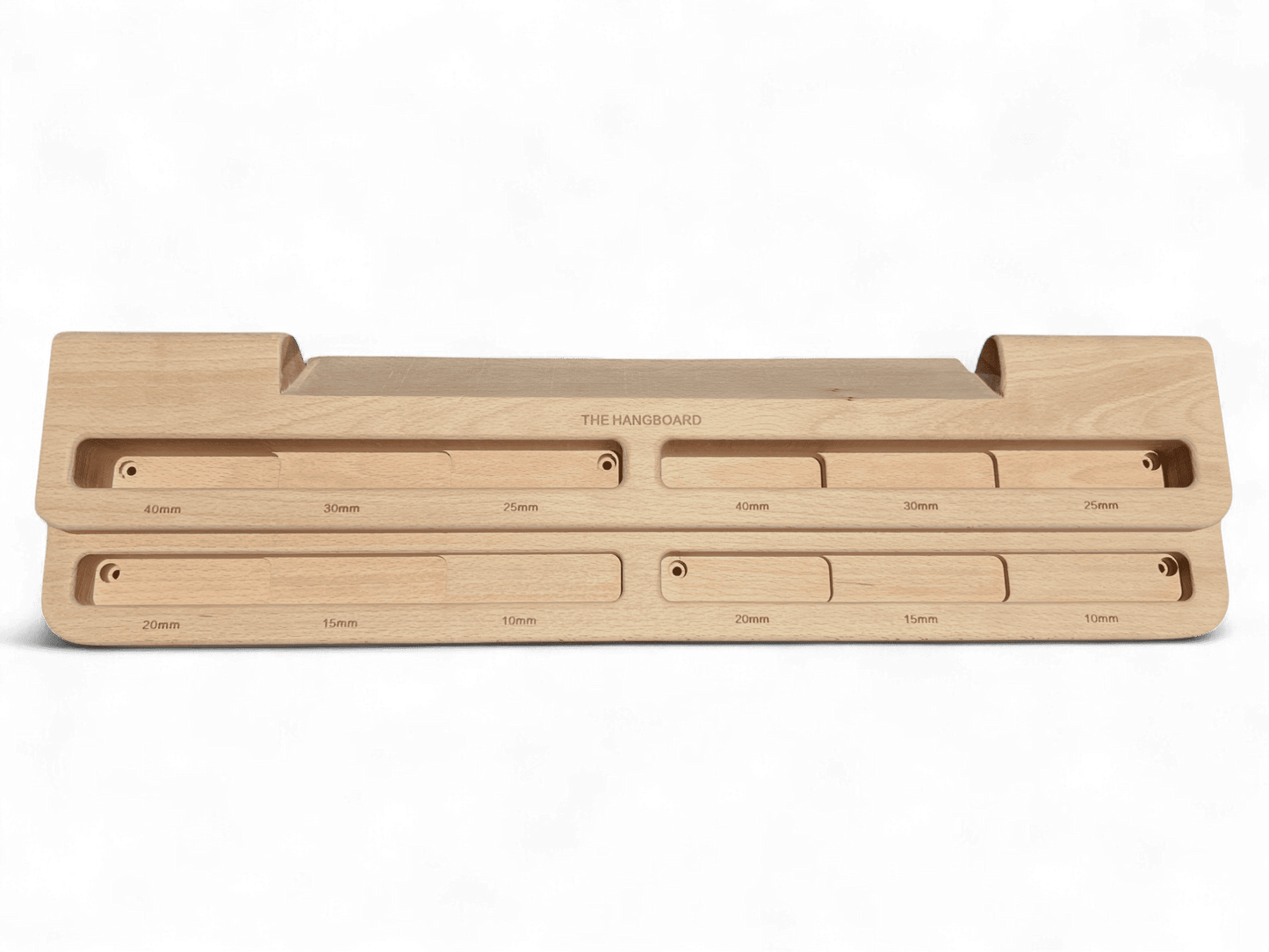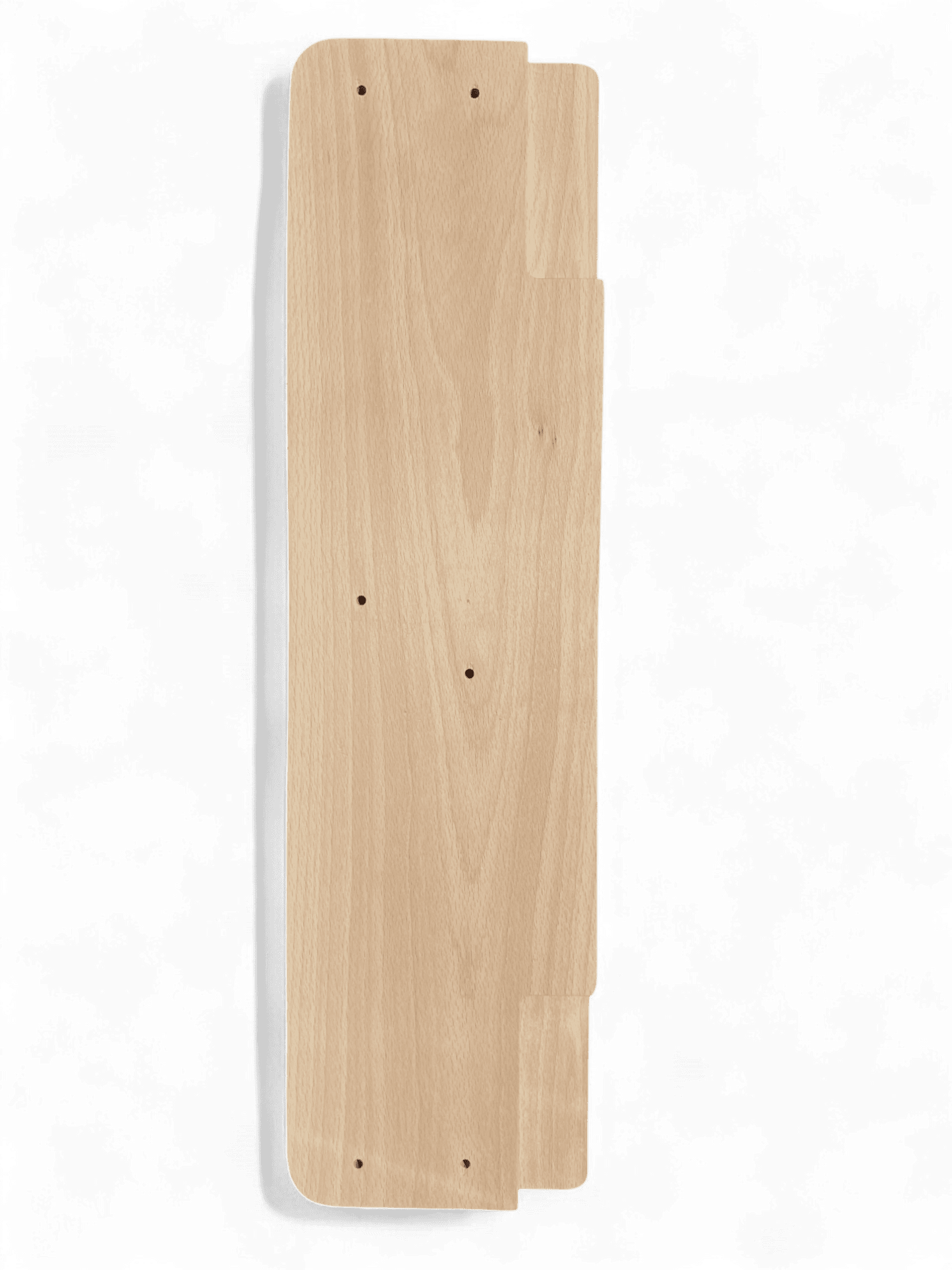There are many different ways to get better at rock climbing. One of the most effective ways to improve your climbing strength and technique is to simply climb like crazy.
However, if you need a more specific avenue to climb harder, you can deploy a special tool to help you attain your climbing goals– a climbing hangboard. A hangboard is one of the simplest yet most effective training tools for rock climbing. You can use it alongside your normal climbing or as a replacement for climbing when you don’t have time to go to the gym.
Keep reading if you are curious about hangboards and how to incorporate hangboarding into your new climbing routine.
What is a hangboard?
A climbing hangboard is a training tool that rock climbers use to improve their maximum finger strength, power endurance, and endurance. Oftentimes, it’s a rectangular board with grips of varying sizes and shapes.
Traditional climbing hangboards are typically mounted on a wall, in a doorway, or anywhere high enough where you can suspend your body. However, there are also portable hangboards that you carry with you to the crag or boulder field and hang from tree branches or bolts.
What is the purpose, and how do people use them?
Climbers use hangboards as a way to mimic the conditions their bodies feel when performing the act of climbing without actually climbing.
You can use a hangboard for short (but potent) workouts. You can also use a hangboard for simply warming up before a session in the gym or trying your project outside.
What do hangboard workouts strengthen?
Hangboards are multifaceted tools that can be used in a variety of hangboard workouts to improve three critical components of a climber’s repertoire.
- Max finger strength
- Power endurance
- Long endurance
Hangboards are an effective way to improve maximum strength, which is essential for climbing harder and harder routes. Finger strength refers to your ability to generate force with your fingers.
Climbing hangboards can also be used to improve endurance, which is important for climbing long routes. Endurance refers to your ability to hang on for a long time without getting pumped. Power endurance is a type of strength that is required for powerful and sustained movements, typical on a sport climb.
Besides improving finger strength and endurance, climbers can use hangboards to perform a variety of other exercises. For example, you can use hangboards to train bigger muscles like the biceps by doing pull-ups. You can also work out your abs with knee raises and front levers.
Different types of climbing hangboards
There are many different types of hangboards available, each with its own unique set of holds. Some hangboards are designed for beginners, while others are designed for more advanced climbers.
The ideal hangboard is one that you can progress with, all the way from a beginner hangboarder to a seasoned and steel-fingered climber. Regardless, it is important to choose a hangboard that is appropriate for your skill level and goals.
Hangboards are also made with various different materials, such as polyurethane. However, the ideal material for hangboards is wood. Wooden hangboards are the most comfortable and is the friendliest to your skin.
Plus, wood hang boards are often used with recycled materials instead of materials derived from fossil fuels, like polyurethane.
Hangboarding hold types
Every hangboard is a little different in terms of the types of grips it has. However, there are five main types of grips that you will find on most well-made hangboards.
- Jugs- large and often incut handles.
- Slopers- flat or rounded edges that slope downwards.
- Pockets- small edges designed only to accommodate one, two, or three fingers.
- Pinches- square or rectangular edges designed for squeezing with your fingers and thumbs.
- Edges- flat, often slightly incut edges in varying sizes designed only for your fingertips.
For a more in-depth look at these hold types and their nuances in rock climbing, check out our comprehensive guide on climbing holds.

How to mount a hangboard
Most hangboards are designed to be installed above a doorway, on ceiling joists or exposed beams, or anywhere where you can hang freely. The exact method of installation will depend on the specific hangboard you are using and where you plan to place it.
However, there are a few commonalities to keep in mind when thinking about how to install a hangboard, regardless of what board you are using.
-
Location is everything- position your hangboard in a location that makes ergonomic sense, meaning it is comfortable and easy to use. You want to be motivated and happy using your hangboard, not stuck in your dark, dank basement.
-
Understand your building- it’s important to know what material your walls are made of and where the wall studs are. You will be putting a lot of force on your hangboard, so proper installation is critical.
- Ensure you are using the correct hardware- what screws you use and how many, and how long they should be will depend on what material you are mounting on. Most hangboards will come with hardware and instructions for installation.
How to use a hangboard
If you are new to hangboarding, it is a good idea to consult with a certified climbing instructor or physical therapist beforehand. They can help you choose the right hangboard for your needs and teach you how to use it safely.
When you are ready to begin hangboarding on your own, here are some safety tips to keep in mind when using a hangboard.
- Always warm up your fingers and forearms before using a hangboard.
- Use a chalk to keep your hands dry.
- Start with easy holds and gradually increase the difficulty as you get stronger.
- Listen to your body and take breaks if you feel pain.
- Do not use a hangboard if you have any injuries to your fingers or forearms.
Hand positions for hangboarding
The most common hand position you will use while hangboarding is the crimp. When it comes to crimping, there are three main hand positions.
Full crimp
A full crimp is when you have all four fingers on the edge and fold your thumb over your index fingernail, locking the crimp in place. The full crimp is the most aggressive and powerful grip type in rock climbing. Therefore, you are most susceptible to injury while in the full-crimp position.
For that reason, full-crimping is never recommended while hangboarding. We only mention it to give you a complete picture of different grip types.
Half-crimp
A half crimp is when you have all four fingers on the edge and your knuckles are bent at a 90-degree angle. In a half crimp, your thumb is not wrapped over your index finger. Instead, your thumb is typically pressed into the side of your index finger.
Open-hand crimp
The open-hand crimp, also known as the three or four-finger “drag,” is when you position three or four fingers on the edge and drag your hand downwards.
Instead of bending your knuckles at a 90-degree angle, your hand hangs openly with the tips of your fingers hooking the edge, forming the shape of an upside “J.”
Compared to the full-crimp grip, the open-hand crimp is much less intense and therefore is a much safer grip position to use while hangboarding.
The top 5 climbing hangboards
There are many different hangboards on the market. They each come with advantages and disadvantages, but fortunately, all of them will help you get stronger.
For more specific details, check out the review of the top five hangboards on the market. However, for a quick overview, here are a few of the takeaways we thought were important.
-
The ergonomics of the hangboard is the most important quality.
-
Second to ergonomics is material, and we prefer wood.
-
A bigger hangboard does not necessarily translate to a better hangboard.
-
A variety of hold types is essential for a well-rounded workout (and avoiding boredom).
-
Your hangboard should be able to meet you where you’re at in terms of strength and then progress with you as you get stronger.
- Some of the most effective hangboards are also the most affordable.
Final thoughts- hangboarding is your catalyst for better climbing
Climbing a lot is one of the best and most fun ways to build strength and improve your technique. However, incessantly climbing can only take you so far. Eventually, you may need an extra boost in your climbing-specific training to help you continue progressing.
A climbing hangboard and a dedicated training routine could make all the difference. They’re the perfect complement to regular on-the-wall training. Hangboards can also function as a replacement for climbing when you need a quick workout.
If you’ve been considering investing in a hangboard to see if it can truly catalyze your climbing, there’s only one way to find out!









